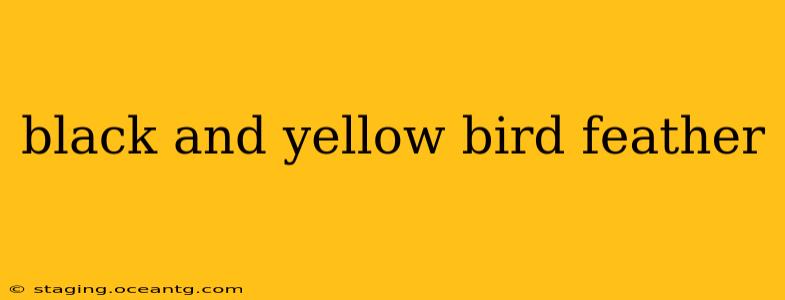Finding a black and yellow bird feather can spark curiosity. Many species boast this striking color combination, making identification a fun challenge. This guide will help you narrow down the possibilities, exploring various bird species and the clues hidden within the feather itself.
What kind of bird has black and yellow feathers?
This question is at the heart of feather identification. The answer, unfortunately, isn't a single bird. Many species incorporate black and yellow in their plumage, often in varying patterns and intensities. To accurately identify the bird, you need more information than just the color. The size and shape of the feather, along with any other distinguishing marks, are crucial clues.
How can I identify a bird feather?
Identifying a bird feather requires careful observation and attention to detail. Several key features can aid in identification:
- Size and Shape: Measure the feather's length and width. Note the overall shape – is it long and pointed, rounded, or barbed? Consider the feather type (primary, secondary, tail, etc.) as these have distinct shapes.
- Color Pattern: Observe the distribution of black and yellow. Is it in stripes, spots, or a more blended pattern? Note the intensity of each color.
- Barbs and Barbules: Examine the feather structure closely. Are the barbs (branches from the central shaft) smooth or ruffled? Do the barbules (tiny branches from the barbs) interlock securely?
- Shaft: The central shaft of the feather can reveal information. Note its thickness, strength, and flexibility.
Remember, a single feather can't always provide a definitive identification. Combining feather characteristics with other information, like the location where you found it, will increase your chances of success.
What are some common birds with black and yellow feathers?
Several birds sport a striking black and yellow combination. While a definitive identification requires more than just color, here are some examples to consider:
- Yellow-rumped Warbler: This common warbler features a bright yellow rump and black streaks on its back.
- Baltimore Oriole: Known for its vibrant orange and black plumage, some variations exhibit a more yellow tone in certain light conditions.
- Black-headed Grosbeak: While primarily black and red, females possess a striking yellow and olive-colored plumage.
- Goldfinches (American Goldfinch): While typically yellow, males in breeding plumage have a rich black cap. Juvenile goldfinches may show a more subdued black and yellow pattern.
- Northern Flicker: This woodpecker features black spots on a yellowish-brown body.
These are just a few examples. Many other birds may display variations of black and yellow in their plumage.
Is there a website or app that can help me identify bird feathers?
While there isn't a single foolproof online resource dedicated solely to feather identification, several helpful tools exist:
- Online Bird Guides: Websites and apps such as All About Birds (allaboutbirds.org) and Merlin Bird ID (from the Cornell Lab of Ornithology) provide detailed information about various bird species, including plumage descriptions and images.
- Field Guides: Traditional field guides remain invaluable tools. These books often feature detailed illustrations and descriptions of bird feathers.
- Bird Identification Forums: Online communities dedicated to bird watching frequently offer assistance with identification questions. Sharing high-quality images of the feather can increase the accuracy of the identification.
Can I use a black and yellow bird feather for crafts?
Absolutely! Many people incorporate naturally shed bird feathers into art and craft projects. However, remember that it's crucial to ensure the feather was ethically sourced. Never collect feathers from live birds or nests. Use only feathers found naturally shed.
By combining careful observation with the resources mentioned above, you can significantly increase your chances of identifying that intriguing black and yellow bird feather. Remember responsible birdwatching practices and ethical sourcing of materials.
